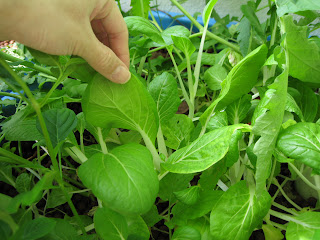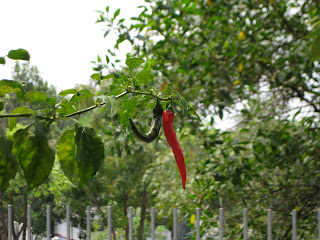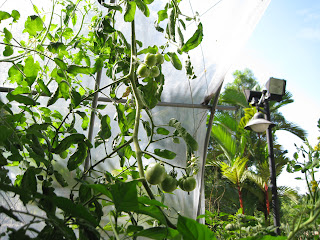Finally! Another update after a long period of dormancy! Not that I totally neglected aquaponics, I just don't have anything fun or nice to show off. Unlike other people's system, mine isn't that successful. No lush jungle growth or monster fish. I've yet to enjoy my first fully aquaponics meal like the one shown in Murray Hallam's video.
Anyway here's an update of my system. I'll start with some old pictures, followed by bad news and then finally the good news!
Here are some NICE old pictures taken over the last 3 months:
17 March
 |
| Overgrown tomato "bush" |
 |
| Bak Choy doing well in the beginning... |
 |
| Single tomato flower. They kept falling off in the beginning. |
 |
| Purple okra never did well. They were infested by aphids. I had them removed later. |
21 March
 |
| Gave the tomato plants some trimming. Lots of flowers but no fruits. |
 |
| Left growbed |
 |
| Ripening chilli fruit |
 |
| Fully ripen chilli next to a green one |
During that time, my chilli plant went berserk and produced around 15 fruits. Juicy chillies! They were hot as well.
15 April
 |
| Trimmed the tomato again. Bak choy showing signs of deficiency. The bottom was also getting overcrowded that time. |
 |
| This is a single piece of root from ONE tomato plant that had been clogging the right growbed's outlet pipe. |
Okay, back to present time. Now the bad news...
The plants have been showing signs of nutrient deficiency. It looks like a lack of potassium or magnesium... or maybe both. I don't really know. Also, I removed all except one Bak Choy plant because they weren't growing so well. Most were stunted with brown edges. I threw most of them in to the tilapia tank.
 |
| Chilli plant had stopped bearing fruits like crazy |
 |
| Leaves yellowing with brown edges. Curled up as well. What could it be? |
 |
| Roselle have not been doing well since the beginning |
 |
| New growth showing sign of chlorosis. Growth is slow too. |
The remedy the problem, I've been adding potassium in to the system in the form of cream of tartar. I couldn't find any other forms of potassium. Previously, I used to bury banana flesh in the growbeds.
For magnesium, I used dolomite lime. It contains calcium and magnesium, but I read from somewhere that I shouldn't use too much of this stuff.
Finally, the good news...! :D
The good news we've all been waiting for!
WE...
HAVE...
TOMATOES!!!
 |
| Indeterminate tomato plants need plenty of space. I'm still learning how to grow them. |
 |
| Green tomato! |
 |
| A red one there! 4 on the left! Don't ask... Yes, I have eaten that one. Firm, sweet, & juicy! |
 |
| More tomatoes! |
My tomatoes didn't bear any fruits at first. Just flowers, no fruits. That was until I started adding cream of tartar in to my system. I wasn't sure how much cream of tartar I'm supposed to put in to my system, so I just added 1 teaspoon every week. I've already stopped adding them and will only continue once my plants show signs of potassium deficiency again.
 |
| This basil plant which once was a mysterious seedling now growing healthily. I wasn't sure how the seed got there. I think it is Genovese. |
Fish water is getting clearer recently. I'm not entirely sure why, but I think it's due to the tomato plants working hard to suck out nitrates from the system which then improves the efficiency of the nitrifying bacteria. Or maybe it's due to the massive tomato root system which helps to capture suspended solids in the water.
It's been a year since I bought my tilapia and they haven't reached plate size yet. They don't eat much; only a handful of pellets everyday. They also don't grow at the same speeds. Some are like 9 inches long while some remained at only 3 inches. I'm not very experienced with fish keeping, but I think water quality effects their growth. It's like the fish instinctively go on a diet to reduce poop saturation levels. Oh well, not that I'm in a hurry.
Thanks for reading!